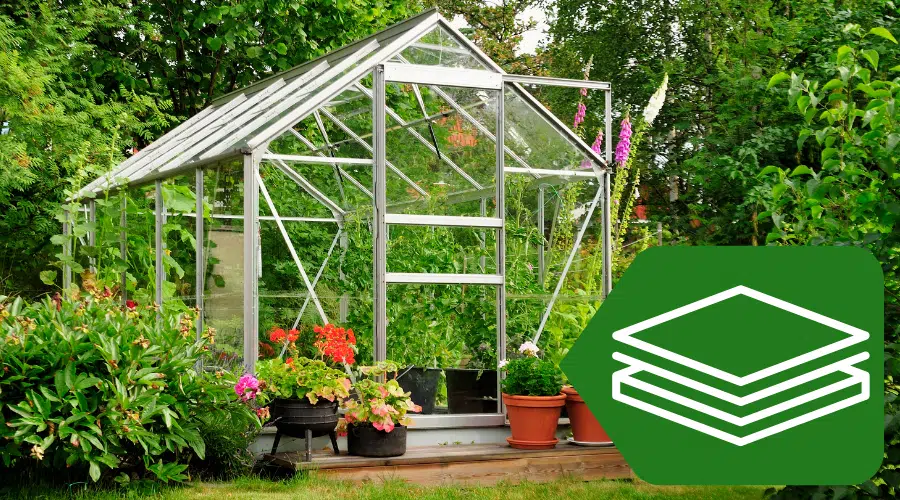
Best Floors & Bases For A Greenhouse
When buying a new greenhouse or if you've already purchased one and are waiting for it to be delivered, then you've probably already decided where in the garden you plan to put it. But there's another key area to this, and that's to think about what type of floor or base to use with it, that your greenhouse will then go on top of.
For the majority of greenhouse models, they can be installed onto a variety of areas such as straight onto a grassy area in the garden (provided it comes with a suitable base plinth to do so), onto a concrete slab, on an area filled with gravel, an area laid with slabs or patio bricks, or a raised wooden plinth or dwarf wall. Knowing how you'd like to site your greenhouse in advance gives you plenty of time to source any required materials and complete any ground work to get the area prepared.
We've collated our list of the best floors and bases to install a greenhouse onto, letting you decide on the best one for you, your garden and your new structure. Carry on reading our guide on the best and most common greenhouse base options, and the advantages and disadvantages of each type.
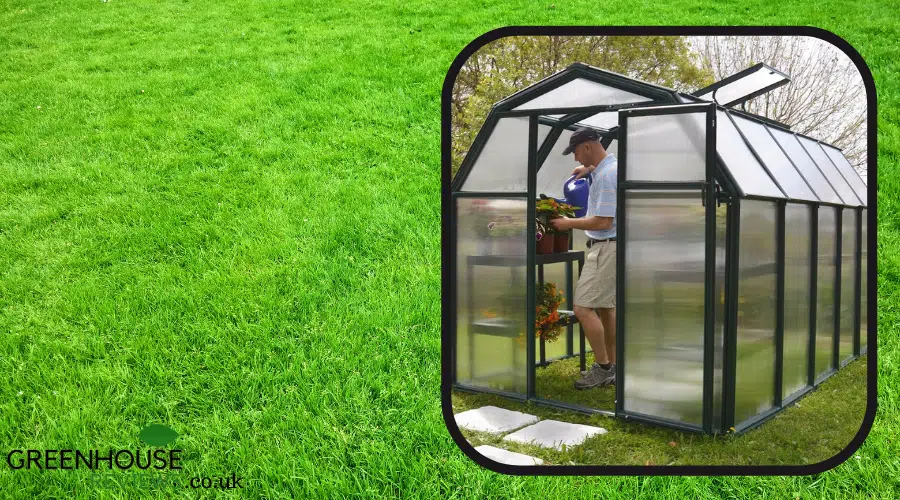
Grass
Installing a greenhouse onto grass, or even soil can be the least expensive, and easiest option.
Although, not always the most rigid and structural sound place to put it, it is possible to install a greenhouse directly onto a grassy or compacted soil surface down the garden. Many greenhouse brands offer their greenhouses with a special base plinth, that has spikes on each corner, designed to be anchored down into the ground. The main greenhouse is then installed on top of this base plinth, and so is indirectly anchored into the soil.
To prepare the site, firstly level it as much as possible. When assembling the greenhouse, make sure to use anchors to secure it to the ground and prevent it from shifting. Regularly check the greenhouse for any signs of settling or unevenness, and make any necessary adjustments to maintain a stable foundation. If the base of your chosen greenhouse doesn't come with any anchoring spikes, then it may be helpful to add a layer of patio bricks or slabs around the perimeter of where your greenhouse frame will touch the ground, in order to provide a stable and level surface for the greenhouse.
Advantages of Grass:
- Installing a greenhouse directly onto a grass area can be less expensive than building a foundation or installing a concrete slab.
- It is generally easier to install a greenhouse directly onto grass than it is to build a foundation or install a concrete slab.
- A greenhouse installed directly onto a grass area can be more easily moved or reconfigured if needed.
Disadvantages of Grass:
- Grass does not provide as much insulation as a solid foundation, so a greenhouse installed directly onto a grass area may be more prone to temperature fluctuations.
- Grass can retain moisture, which can lead to dampness and mold in the greenhouse.
- A greenhouse installed directly onto a grass area may be more vulnerable to pests such as mice and moles.
- Some plants may not thrive in a greenhouse installed directly onto a grass area due to the lack of insulation and potential moisture issues.
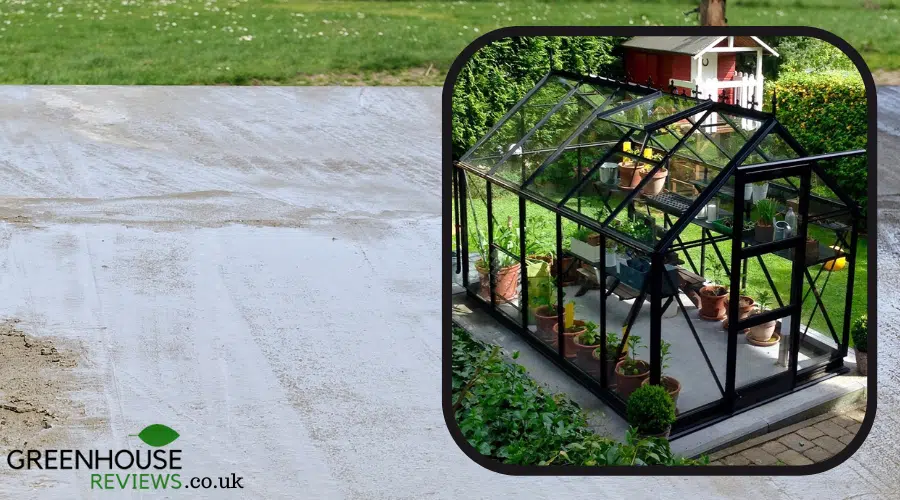
Concrete
A concrete base, also known as a concrete slab is a solid and durable option for supporting a greenhouse. It can be poured to the desired size and shape to fit the greenhouse, and it will not shift or settle over time. However, it can be expensive to install with the purchase of the concrete mix and batons, and for many of us would usually require the hiring of a professional builder or landscaper to complete the job if unable to DIY.
Advantages of Concrete:
- A greenhouse installed onto a concrete slab is more durable and long-lasting than one installed directly onto a grass area.
- A concrete slab provides better insulation than grass, helping to regulate the temperature inside the greenhouse.
- A greenhouse installed onto a concrete slab is less likely to be damaged by pests such as mice and moles.
- A greenhouse installed onto a concrete slab may be able to support a wider range of plants due to the better insulation and pest resistance.
Disadvantages of Concrete:
- Installing a greenhouse onto a concrete slab is more expensive than installing it directly onto a grass area.
- It can be more difficult to install a greenhouse onto a concrete slab than it is to install it directly onto a grass area.
- A greenhouse installed onto a concrete slab is more permanent and may be more difficult to move or reconfigure.
- A concrete slab may crack over time, which could damage the greenhouse.
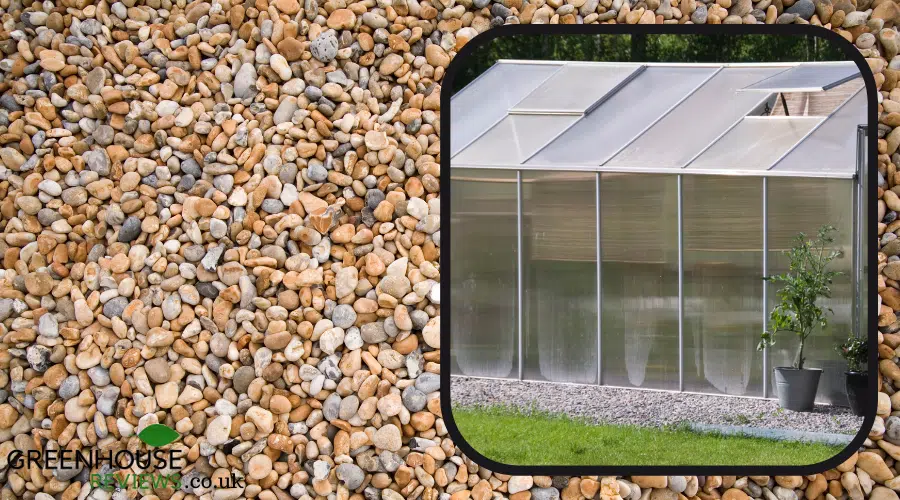
Gravel
A gravel base is a less expensive option that can be easy to install and maintain a greenhouse onto. Generally, a graveled area is easy enough to create yourself after you have sourced the gravel, or had some delivered to your home. Gravel naturally provides good drainage and can be used on a variety of soil types, it can also be virtually weed-free if used with a good-quality weed fabric underneath. However, it may not be as stable as a concrete base and may shift over time from heavy rain and soil movement underneath.
Advantages of Gravel:
- Gravel allows for good drainage, which can help to prevent excess moisture in the greenhouse.
- A greenhouse installed onto a graveled area is less likely to be damaged by pests such as mice and moles.
- A greenhouse installed onto a graveled area may be able to support a wider range of plants due to the better drainage and pest resistance.
Disadvantages of Gravel:
- Gravel does not provide as much insulation as a solid foundation or concrete slab, so a greenhouse installed onto a graveled area may be more prone to temperature fluctuations.
- Due to gravel not being solid, it can be more difficult to install a greenhouse onto a graveled area than it is to install it directly onto a grass area or onto a concrete slab.
- A greenhouse installed onto a graveled area is more permanent and may be more difficult to move or reconfigure.
- Some plants may not thrive in a greenhouse installed onto a graveled area due to the lack of insulation and potential moisture issues.
- The gravel may need to be replenished or maintained over time, which can be time-consuming and costly.
- A greenhouse installed onto a graveled area may be more prone to wobbling or unevenness, which can affect the stability of the structure.
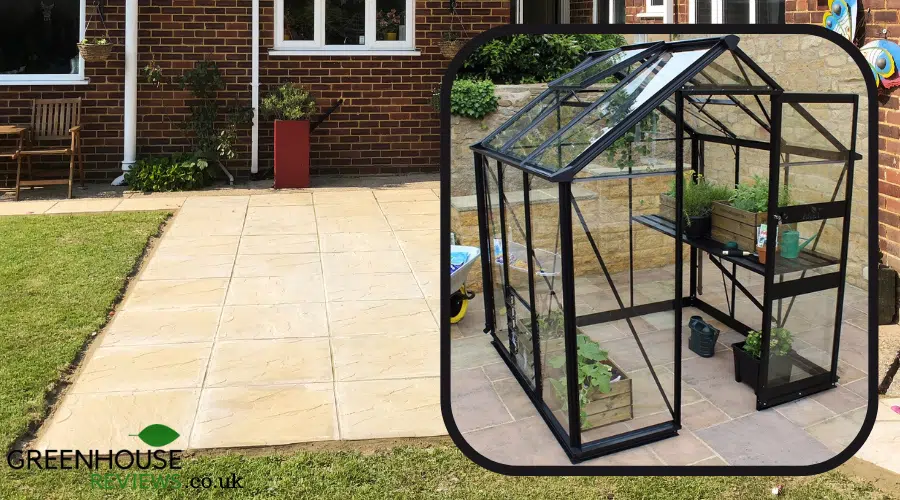
Slabs or Patio Bricks
An area with slabs or patio bricks laid down can be used to create an effective base for a greenhouse. They provide a stable and level surface, with good anchorage, and can be easily repositioned to a different area of the garden if needed. One the materials have been delivered, creating a slabbed area in the garden is not overly difficult to DIY, however, slabs can be very heavy and creating a flat floor can be tricky, so the groundwork may need to be outsourced by a builder or landscaper team.
Additionally, slabbed and patio brick floors may not be as durable as a concrete base and may not provide as much support for the greenhouse, although is certainly more stable than grass or gravel.
Advantages of Slabs or Patio Bricks:
- A greenhouse installed onto a slabbed area is more durable and long-lasting than one installed directly onto a grass area or onto a graveled area.
- A slabbed area provides better insulation than grass or gravel, helping to regulate the temperature inside the greenhouse.
- A greenhouse installed onto a slabbed area is less likely to be damaged by pests such as mice and moles.
- A greenhouse installed onto a slabbed area may be able to support a wider range of plants due to the better insulation and pest resistance.
Disadvantages of Slabs or Patio Bricks:
- Installing a greenhouse onto a slabbed area is more expensive than installing it directly onto a grass area or onto a graveled area.
- It can be more difficult to install a greenhouse onto a slabbed area than it is to install it directly onto a grass area.
- A greenhouse installed onto a slabbed area is more permanent and may be more difficult to move or reconfigure.
- A slabbed area may crack over time, which could damage the greenhouse.
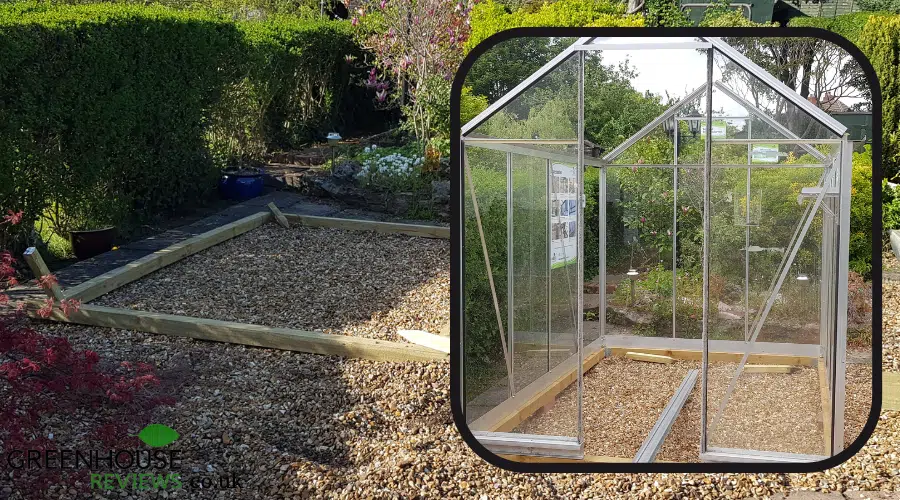
Wooden Plinth
A wooden plinth can be a very cheap option to create a base to install a greenhouse onto, and is very easy to make yourself with the use of timber fence posts simply laid on the ground and anchored down to the ground with wooden spikes.
Not only can it provide a way to anchor the greenhouse down to the ground indirectly, but it also raises the greenhouses up a little, giving more internal height inside for taller growing plants such as tomatoes.
It can be built to the desired size and shape of the greenhouse and can be easily adjusted or relocated around the garden if you ever decide to move where your greenhouse is sited. However, it may not be as durable as a concrete base and may require more maintenance over time, as timber generally lasts around 10-15 years (if pressure treated, much less for dip-treated) before needing to be replaced.
Advantages of a Wooden Plinth:
- A raised wooden baton plinth allows for good drainage, which can help to prevent excess moisture in the greenhouse.
- A greenhouse installed onto a raised wooden baton plinth is less likely to be damaged by pests such as mice and moles.
- A greenhouse installed onto a raised wooden baton plinth may be able to support a wider range of plants due to the better drainage and pest resistance.
- A greenhouse installed onto a raised wooden baton plinth provides an elevated growing space, which can be easier to access and work in.
Disadvantages of a Wooden Plinth:
- A wooden baton plinth does not provide as much insulation as a solid foundation or concrete slab, so a greenhouse installed onto a raised wooden baton plinth may be more prone to temperature fluctuations.
- It can be more difficult to install a greenhouse onto a raised wooden baton plinth than it is to install it directly onto a solid foundation or onto a concrete slab.
- A greenhouse installed onto a raised wooden baton plinth is more permanent and may be more difficult to move or reconfigure.
- Some plants may not thrive in a greenhouse installed onto a raised wooden baton plinth due to the lack of insulation and potential moisture issues.
- The wooden baton plinth may need to be maintained or replaced over time, which can be time-consuming and costly.
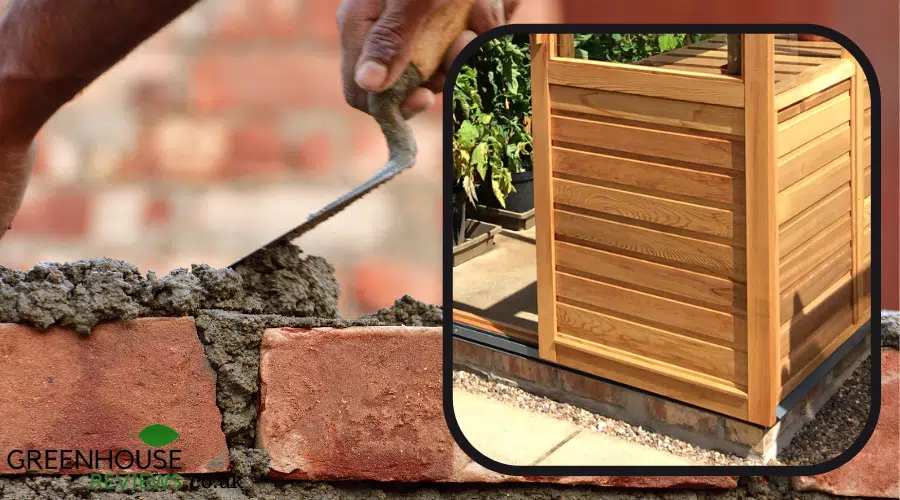
Dwarf Wall
A dwarf wall, or low retaining wall, can be used to create a base for a greenhouse that allows the perimeter of the structure to sit on top of and to be anchored down to. It provides a stable and level surface and can be built to the desired size and shape. However, it may be more expensive to install than some of the other options and will often require the hiring of a professional builder of landscape to build the wall to the exact measurements.
Advantages of a Dwarf Wall:
- A dwarf wall provides better insulation than a grass or graveled area, helping to regulate the temperature inside the greenhouse.
- A greenhouse installed onto a dwarf wall is less likely to be damaged by pests such as mice and moles.
- A greenhouse installed onto a dwarf wall may be able to support a wider range of plants due to the better insulation and pest resistance.
- A greenhouse installed onto a dwarf wall provides an elevated growing space, which can be easier to access and work in.
Disadvantages of a Dwarf Wall:
- Installing a greenhouse onto a dwarf wall is more expensive than installing it directly onto a grass or graveled area.
- It can be more difficult to install a greenhouse onto a dwarf wall than it is to install it directly onto a solid foundation or onto a concrete slab.
- A greenhouse installed onto a dwarf wall is more permanent and may be more difficult to move or reconfigure.
- The dwarf wall may need to be maintained or repaired over time, which can be time-consuming and costly.
- Some plants may not thrive in a greenhouse installed onto a dwarf wall due to the lack of insulation and potential moisture issues.
Conclusion
To conclude, there's not one 'ultimate' or 'best' floor style to install your greenhouse onto, and the method best for you will vary depending on your garden, your needs, DIY capability and chosen greenhouse model.
The main thing to consider, with whichever type you go with is to ensure that there's a sufficient way to anchor the greenhouse down to ground level. This is what will give your new structure the integrity that it needs to withstand our great British weather, harsh winds, and to stay strong and stable season after season. So make use of ground spikes, anchor bolts or a similar anchoring method where possible for maximum benefit.








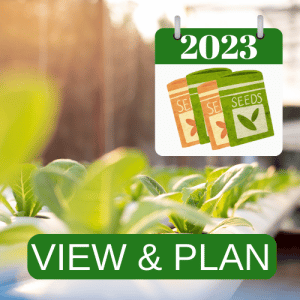

No comments.